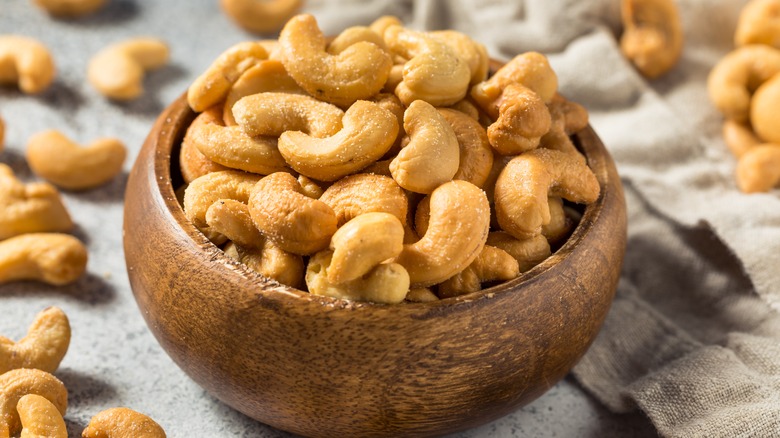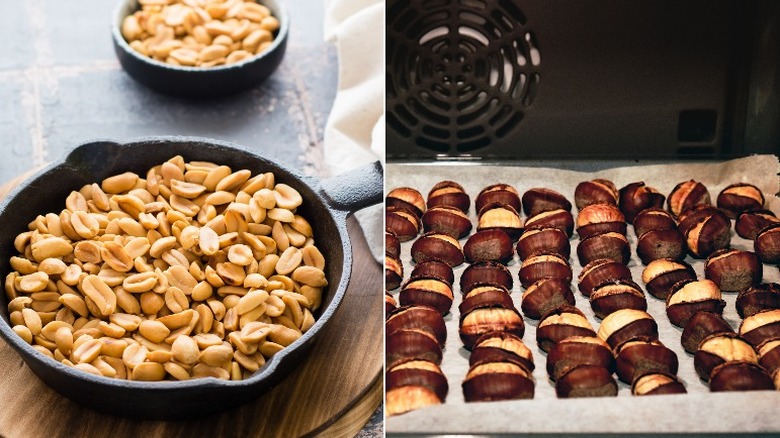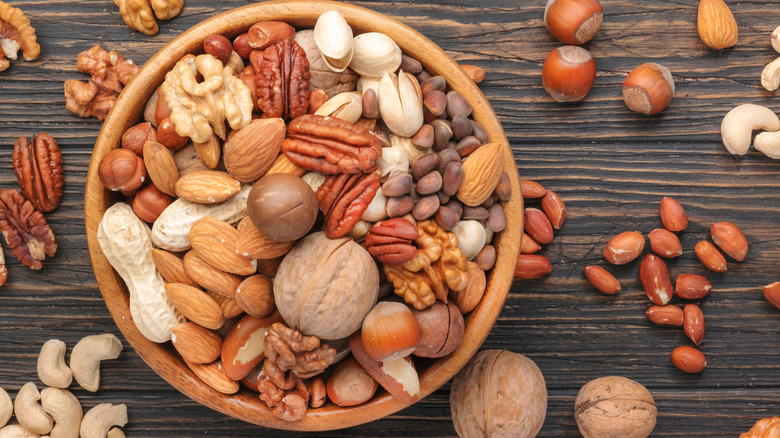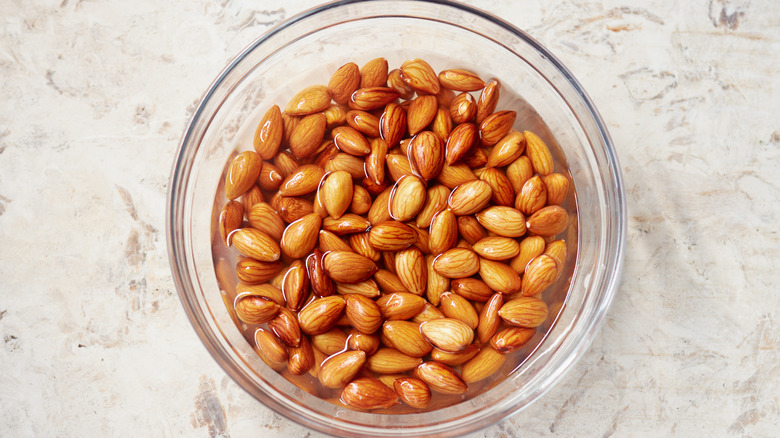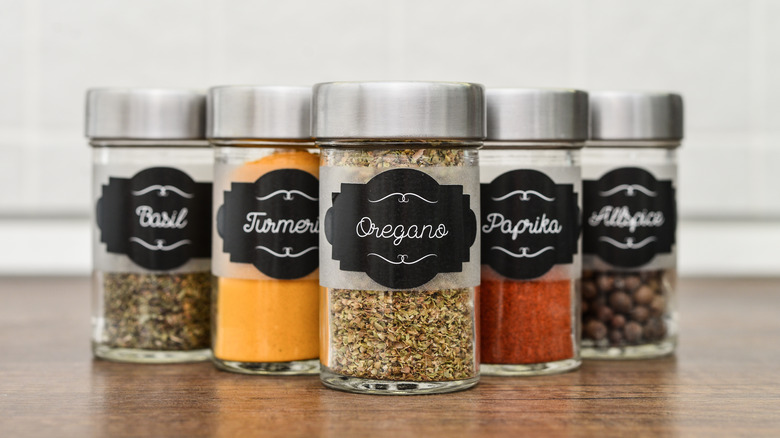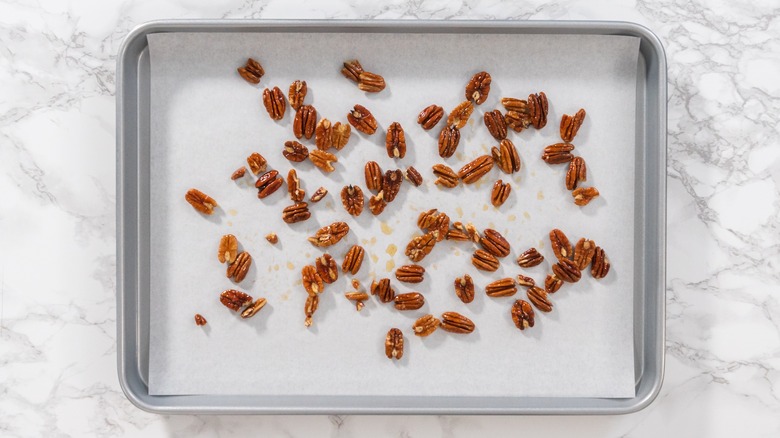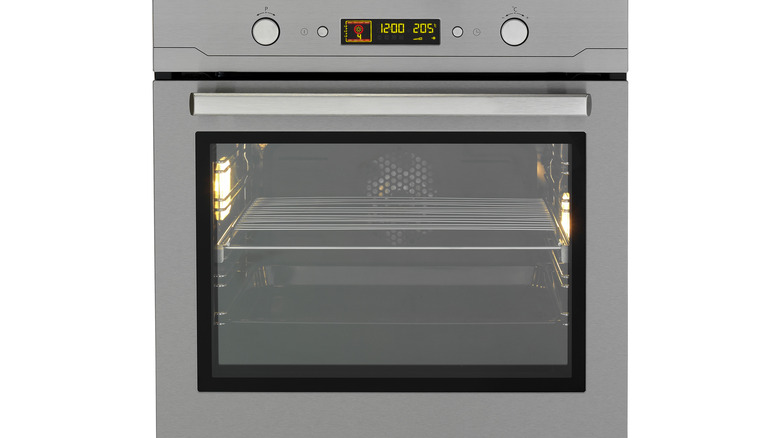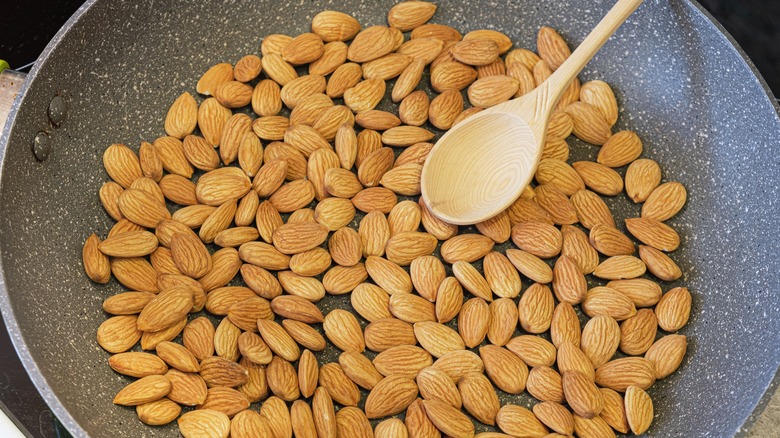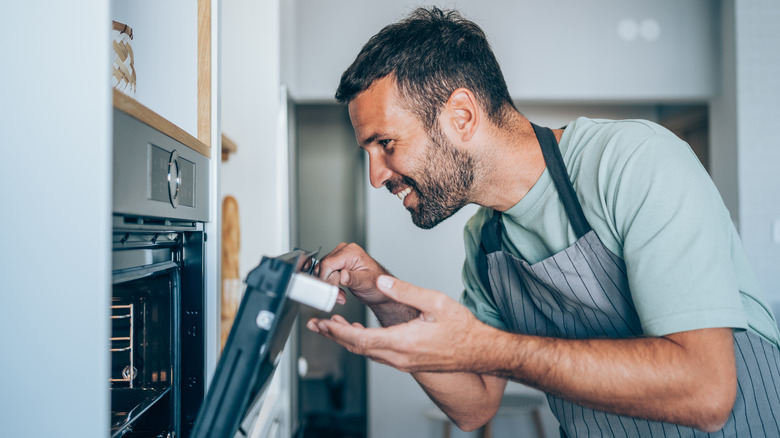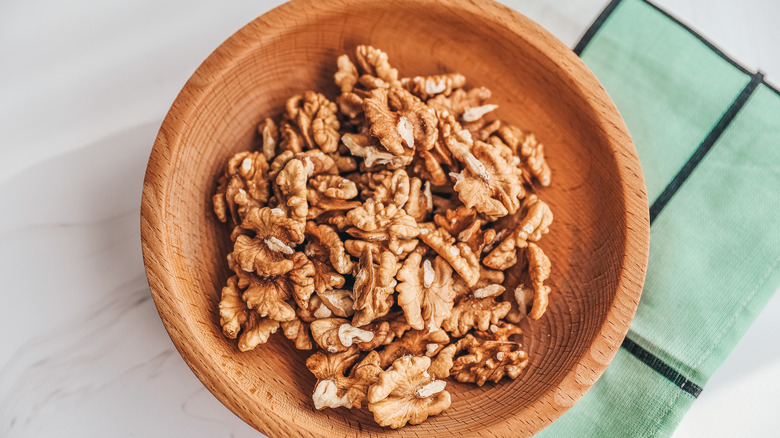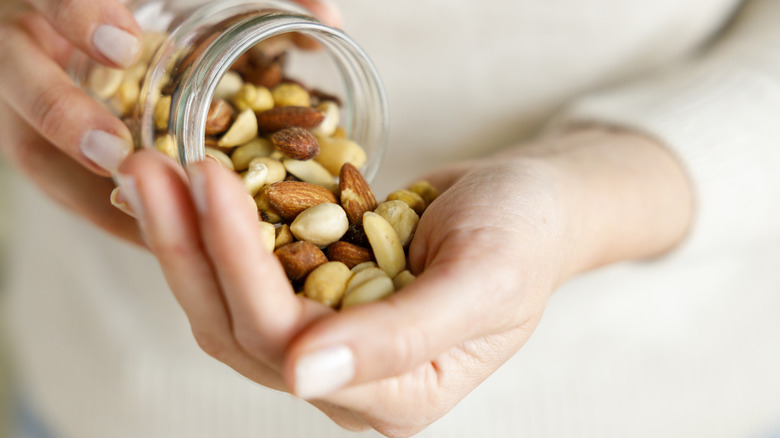12 Tips You Need For Roasting Nuts At Home
Whether snacking on some during the big game, sprinkling a few on top of an açai bowl, or guzzling them down in the form of plant milk, nuts have a huge place in the modern kitchen (and stomach). They are beloved for their innumerable health benefits, delicious flavor, and satisfying crunchiness. But beyond that, they're one of those foods that continues to surprise us. A simple change in seasoning or cooking method is enough to transform even the simplest nuts into a satisfying delicacy.
One of the best ways to give nuts that extra oomph is by roasting them. Regardless of the type of nut, roasting brings out new aromas, increases the crunch factor, and deepens the flavor. These new-and-improved nuts are delectable all on their own, but they also add a hearty richness to salads, cookies, and quick bread. You probably don't need any more convincing as to why you should be roasting nuts, but you might need some guidance. Follow this advice, and you'll become an expert nut roaster in no time.
Learn the different roasting methods
When you search for tips about roasting nuts, you'll quickly realize that most sites don't distinguish between roasting nuts and toasting nuts. While it's true that the two cooking methods are similar (they involve heating nuts to bring out their aromas and flavors), there are differences. Toasting nuts is a more superficial process that usually takes place on the stovetop. On the other hand, roasting is a longer process completed in the oven or a bread machine. This extra time produces stronger aromas and flavors than can be found in toasted nuts.
Toasting nuts on the stovetop is the most common method; other ways exist to achieve the toasty goodness you're after. For example, you can toast nuts in the microwave. This method requires lots of hands-on attention, but it's faster than the pan and oven. Alternatively, you can toast nuts in an air fryer. Air fryer toasting is about as simple as it gets and only takes about five minutes.
Use raw nuts
Most of the nuts you find in the grocery store are dry roasted, salted, or both. While these varieties make for tasty snacks, they're not ideal for home roasting. It's not the end of the world if you roast them, but you may end up with a saltier dish than you bargained for if you combine roasted nuts with other salt-heavy ingredients. To avoid over-salting your dish, season and roast raw nuts yourself. Choosing raw nuts also allows you to control the amount of oil you're consuming. For these reasons, raw nuts are much healthier than their pre-packaged counterparts.
While raw nuts are better for you, they're usually more expensive than pre-roasted varieties. That's because raw nuts have a shorter shelf life. As a result, more effort is needed to keep fresh nuts stocked, which drives up the price. It's also worth noting that certain types of raw nuts may be more difficult to locate. Some grocery stores stock them (especially in the bulk section), but you might have to go to a specialty store to track them down. Despite the extra cost and effort, using raw nuts is worth it if you're serious about roasting nuts at home.
For a crunchier texture, soak nuts before roasting
There are a few reasons to soak nuts. The one that's gotten the most attention lately is that soaking nuts helps your body better absorb nutrients. Many nuts contain phytic acid and enzyme inhibitors. These substances help nuts survive in the wild but can make digestion difficult for humans. Soaking nuts helps eliminate these compounds, increasing digestion and nutrition uptake.
That's all well and good, but we're more interested in the second reason for soaking nuts: improving taste and texture. Soaking nuts helps remove bitter tannins from the skin. What's left behind is a softer, creamier nut that won't make you pucker. Using these better-looking and tasting nuts is the key to that roasted nut crunchiness you're after. If you're convinced, place nuts in a bowl of warm or room temperature water, add one to two tablespoons of sea salt, and leave to soak for several hours. Harder nuts like almonds or Brazil nuts can soak for up to seven hours, but softer varieties like cashews and pecans shouldn't soak for more than six hours.
Don't be afraid to season
Roasting nuts already does a lot to bring out their rich, earthy flavors. But if you're eating them plain, you're missing out on a wide world of flavor possibilities. Depending on which herbs and spices you add, your nuts can be burn-your-mouth spicy, delightfully sweet, or something in between. No matter which flavor profile you're after, feel free to get creative. Nuts have a pretty neutral flavor, making them an excellent canvas for almost anything you put on top.
If you want to add flavor to your nuts but don't know where to start, try making a batch of roasted almonds with crispy herbs. The recipe combines sage, rosemary, cumin seeds, and cayenne pepper to create a savory snacking experience. Looking for something spicy? Try our recipe for spiced roasted almonds. Use these recipes as inspiration, but don't limit yourself to them. Bold seasonings like curry powder, paprika, and chili powder come alive when added to nuts.
Use egg whites to make seasonings stick
If you're already a seasoned nut roaster, you might be looking for ways to up your game. Sure, you could experiment with new flavor combinations, but what about perfecting the recipes you already know? Doing so doesn't involve messing with your spice blend — we're sure you've got that down pat. Rather, it involves prepping your nuts with a deceptively simple ingredient before adding your proprietary ingredients.
The ingredient in question is whipped egg whites. Egg whites are like glue. They help spices stick to nuts, ensuring flavor in each bite. On top of that, they give your nuts a satisfyingly crispy outer shell after they come out of the oven. Separate an egg into whites and yolk to make the perfect egg wash. Put the yolk aside and pour the egg whites into a bowl. Mix a teaspoon of water into the egg whites and whip until foamy. Pour over nuts and toss to blend. Once coated, cover the nuts with your favorite blend of spices. We're particularly fond of cinnamon sugar roasted nuts, but feel free to experiment with your favorite flavors.
Arrange nuts correctly
There are all kinds of ways to roast nuts at home, but these methods all have something in common. Whether you're toasting nuts in a frying pan or roasting them on a sheet pan in the oven, you have to make sure the nuts are arranged in a single layer. Spreading nuts out ensures that every nut is cooked evenly. Fail to do so, and some nuts will end up burnt, while others will remain raw.
If you have too many nuts to roast and not enough space, then you have two options: either modify your roasting method or roast in batches. To the first point, microwave or pan roasting is best for small batches (one cup of nuts or less), while oven roasting gives you room to roast several cups of nuts at a time. If you've got a lot of nuts to roast, but you really want to use the microwave or pan method, then set already-roasted nuts aside to make room for additional batches.
Control the temperature
Perfectly roasted nuts are like fine wine — both require time to fully develop their complete flavor profile. Like fermenting grapes, there's not much you can do to speed up the nut-roasting process. Increasing the oven temperature may seem like an appealing way to save a couple of minutes, especially when you're in a hurry, but we beg you not to. Slow roasting for a longer time ensures even roasting and prevents nuts from burning.
While pretty much everyone agrees that slow roasting is the way to go, there isn't much consensus when it comes to temperature and cooking times. Some chefs recommend roasting nuts for an hour in an oven set to 200 degrees Fahrenheit, while others claim that 12 minutes in a 350-degree Fahrenheit oven produces the same results. Like anything in the kitchen, we encourage you to experiment with different temperatures and roasting times. That said, 350 degrees Fahrenheit is the maximum temperature we recommend. Anything higher, and you risk burning the nuts.
Adjust cooking times for different types of nuts
Not only do you have to be careful with temperature when roasting nuts at home, but you also have to pay attention to cooking times. Over-roasted nuts taste burnt, and there's not much you can do to resuscitate them. Paying attention to cooking times (especially when roasting a new type of nut) is the easiest thing you can do to avoid a costly mistake.
As you might expect, lighter nuts with softer flesh take less time to roast. This includes varieties like pecans, pistachios, cashews, and walnuts. On average, these varieties of nuts take seven to nine minutes to roast at 350 degrees Fahrenheit. Dense nuts such as almonds, hazelnuts, and macadamias take eight to 10 minutes to roast at the same temperature. The difference in cooking times might seem insignificant, but nuts can quickly go from perfectly golden brown to inedible in seconds. For this reason, we recommend keeping an eye on the oven and batch-roasting similar types of nuts together.
Stir frequently
After reading the last couple of tips, you wouldn't be blamed for coming away with the impression that roasting nuts is a lot of work. After all, you've got to control the temperature and watch the clock like your meal depends on it. But there's one other roasting step to be aware of — frequent stirring. That's right — it's not enough to slow-roast nuts at a low temperature; you've got to rotate them on a regular basis to ensure equal roasting throughout.
If you're roasting nuts in a cooler oven (less than 300 degrees Fahrenheit), we recommend stirring every 10 minutes. On the other hand, if you're roasting at a higher temperature (around 350 degrees Fahrenheit), you should stir every three to five minutes. Other methods, like pan toasting, require even more vigilance, requiring you to stir nuts every minute or so. The same goes for microwave toasting. You should rotate the nuts every minute until toasted.
Trust your nose, not your eyes
Even if you're a roasted nut newbie, you know what perfectly roasted nuts smell like — rich, earthy, and maybe even a bit festive at certain times. We're not saying this to make you drool but rather to remind you what to aim for when roasting nuts at home. Nuts can be pretty finicky when it comes to cooking times, and the clock isn't always the best indicator of doneness. In fact, relying too much on a timer could lead to bitter or even burnt nuts.
So instead of keeping your eyes glued to the clock, clear out your sinuses and let your nose guide you. As soon as you smell the heavenly aroma of roasted nuts, remove them from the heat. It may sound scary to rely solely on your nose, but trust us, the intuition you gain from using your senses is possibly the most reliable method for perfectly roasted nuts that's out there.
Remove nuts from heat immediately
If you've been paying attention, you know your nose is the best guide when it comes to nut cooking times. As soon as you smell the nutty sweetness, it's time to remove the nuts from the heat source. But that's not the end of it. You've got to transfer the nuts from the cooking vessel to a cool, heat-resistant container as soon as possible. Indirect heat from the sheet or frying pan will continue to roast the nuts.
This may seem like an unnecessary extra step, but without finding a cooling tray, your nuts can shift from perfectly roasted to slightly burnt in less than a minute. Once you've moved the nuts to safer ground, allow them to cool for about 10 minutes before serving. The same holds true if you're using roasted nuts for baking. Cooling time prevents burnt mouths and allows fats to resolidify, something that's essential for crunchy nuts.
Eat them quickly
Like sandwiches, salads, and burgers, roasted nuts are best the day you make them. Still, you don't have to stuff yourself in order to use them up. Freshly roasted nuts retain their richest flavor and most satisfying crunchiness for up to three days. After that, you can still eat them. Just be aware that they won't be as aromatic or flavorful as they once were.
The best place to store roasted nuts is inside an airtight container. Either glass or plastic will do the job. Just make sure the nuts are cool before packing them away. If you're storing nuts in the pantry, make sure to eat them within a week or two. Alternatively, you can store them in the refrigerator for up to a month. You can even store roasted nuts in the freezer for up to a year. They may become a bit soggy as they thaw, but a 15-minute stay in the oven at 150 degrees Fahrenheit is all that's needed to perk them up.
